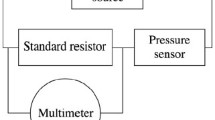Abstract
Steel pycnometers are used to determine density of liquids and gases at different temperatures and pressures. In order to determine this density with reliability, it is necessary to define the mass and the volume of this artifact with the best possible accuracy. This work proposes a methodology for calibrating this artifact, using the gravimetric method, in the pressure range from 1 bar (0.1 MPa) up to 96 bar (9.6 MPa), at the temperature of 20 °C, using Ethanol Pa (with 95% purity in volume). The results of uncertainty of volume for ambient conditions are shown here. The pycnometer volume equation was developed in the pressure range of 1 bar (0.1 MPa) up to 96 bar (9.6 MPa) for the temperature of 20 °C, whose uncertainty found was 0.055 cm3 (0.006%).

Source: Inmetro Fluid Laboratory (Laflu)

Source: API [18]

Source: Inmetro Fluid Laboratory (Laflu)

Source: Inmetro Fluid Laboratory (Laflu)

Source: Inmetro Fluid Laboratory (Laflu)

Source: JJ Junior


Similar content being viewed by others
References
Fujii K et al (1995) Absolute measurement of the density of silicon crystals in vacuo for a determination of the Avogadro constant. IEEE Trans Instrum Meas 44(2):542–545. https://doi.org/10.1109/19.377902
Fujii K, Waseda A, Tanaka M (2000) Density measurements of silicon crystals by hydrostatic weighing. Conference on precision electromagnetic measurements. Conference digest. CPEM 2000 (Cat. No.00CH37031)
Diaz J, Becerra L, Centeno L, Castillo F, Bravo U (2010) Desarrollo de Materiales de Referencia Certificados en Densidad. Simposio de Metrología, México
ISO 15212-1 (1998) Oscillation—type density meters—part 1: laboratory instrument
SIM Guidelines on the calibration of oscillation-type density meters - SIM MWG7/cg-02/v.00 – 2016
Lorefice Salvatore, Malengo Andrea (2006) Calibration of hydrometers. Meas Sci Technol 17:2560–2566
Lorefice S, Malta D, Pinheiro JJO, Marteleto PR (2010) Bilateral comparison on the calibrations of hydrometers for liquid density between Inrim–Italy and Inmetro–Brazil: SIM.M.D-S2. Metrologia 47:07011 (Technical Supplement)
ISO 3507 (1999) Laboratory glassware—pycnometers
Gonçalves FAMM, Trindade AR, Costa CSMF, Bernardo JCS, Fonseca IMA, Ferreira AGM (2010) PVT, viscosity and surface tension of ethanol: New measurements and literature data evaluation. J Chem Thermodyn 42(8):1039–1049. https://doi.org/10.1016/j.jct.20103.022
Sommer D, Kleinrahm R, Span R, Wagner W (2011) Measurement and correlation of the (p, ρ, T) relation of liquid cyclohexane, toluene, and ethanol in the temperature range from 233 K to 473.15 K at pressures up to 30 MPa for use as density reference liquids. J Chem Thermodyn. https://doi.org/10.1016/j.jct.2010.08.010
Mirica KA, Shevkoplyas SS, Phillips ST, Gupta M, Whitesides GM (2009) Measuring densities of solids and liquids using magnetic levitation: fundamentals. J Am Chem Soc 131(29):10049–10058. https://doi.org/10.1021/ja900920s
Lorefice S, Romeo R, Santiano M, Capelli A (2014) Original pycnometers for volatile liquid density over wide ranges of temperature and pressure: practical example. Metrologia 53(3):154. https://doi.org/10.1088/0026-1394/51/3/154
dos Santos Júnior JJP, Marteleto PR, Siqueira JRR, Barbosa APF, da Costa SRR (2008) Utilização do método da pesagem hidrostática para determinação da massa específica de líquidos.I CIMMEC 1° CONGRESSO INTERNACIONAL DE METROLOGIA MECÂNICA, outubro/2008
Bettin H, Spieweck F (1990) A revised formula for the calculation of alcoholometric tables. PTB Mitteilungen 100(6/90):457–460
ABNT NBR 5992:2008. Tabelas Alcoolométricas (“Alcoholometric Tables”)
Tanaka M et al (2001) Recommended table for the density of water between 0 °C and 40 °C based on recent experimental reports. Metrologia 38(4):301
Santos Júnior JJ P, Santo Filho DME, Estudo da contribuição da massa específica da água pura na calibração do volume de um recipiente. https://doi.org/10.13140/rg.2.1.2550.6720 Conference: METROSUL IV–IV Congresso Latino-Americano de Metrologia “A METROLOGIA E A COMPETITIVIDADE NO MERCADO GLOBALIZADO”
API, American Petroleum Institute, Manual of Petroleum Measurement Standards. API Energy, chapter 14: Natural gas fluid, section 6: Installing and proving density meters used to measure hydrocarbon liquid with densities between 0.3 to 0.7 gm/cc at 15.56 °C (60°F) and saturation vapor pressure, (1991)
Lemmon WE, Span R (2006) Short fundamental equations of state for 20 industrial fluids. J Chem Eng Data 51(3):785–850
OIML R111-1 (2004) Weights of classes E1, E2, F1, F2, M1, M1-2, M2, M2-3 and M3:1, metrological and technical requirements
ISO 4787 (2010) Laboratory glassware—volumetric instrument—methods for testing of capacity and for use
Picard A et al (2008) Revised formula for the density of moist air (CIPM-2007). Metrologia 45(2):149
ISO 15212-2 (2002) Oscillation—type density meters—part 2: process instruments for homogeneous liquids
Wagner W, Pruß A (2002) The IAPWS formulation 1995 for the thermodynamic properties of ordinary water substance for general and scientific use. J Phys Chem Ref Data 31:387. https://doi.org/10.1063/1.1461829
JCGM 100:2008 GUM 1995 with minor corrections—evaluation of measurement data—guide to the expression of uncertainty in measurement
EA-4/02, 1ª Edição Brasileira: Expressão da Incerteza de Medição na Calibração
EURAMET cg-19 (2018) Guidelines on determination of uncertainty analysis in volume measurements—EURAMET Calibration Guide No. 19 Version 3.0 (09/2018)
Cox MG (2007) The evaluation of key comparison data: determining the largest consistent subset. Metrologia 44:187–200. https://doi.org/10.1088/0026-1394/44/3/005
Acknowledgements
Santos Junior J.J.P. is grateful to PRONAMETRO; R.G. Pereira is grateful to the National Research Council of Brazil, CNPq, and M. Rosendahl is grateful to PRONAMETRO and UNESA for the financial support.
Author information
Authors and Affiliations
Corresponding author
Ethics declarations
Conflict of interest
The authors declare that they have no conflict of interest.
Additional information
Technical Editor: Jose A. R. Parise.
Publisher's Note
Springer Nature remains neutral with regard to jurisdictional claims in published maps and institutional affiliations.
Rights and permissions
About this article
Cite this article
Santos Junior, J.J.P., Pereira, R.G., Rosendahl, M. et al. The use of ethanol to determine the volume of a pycnometer used to measure the density of liquids at different temperatures and pressures. J Braz. Soc. Mech. Sci. Eng. 42, 50 (2020). https://doi.org/10.1007/s40430-019-2107-y
Received:
Accepted:
Published:
DOI: https://doi.org/10.1007/s40430-019-2107-y




